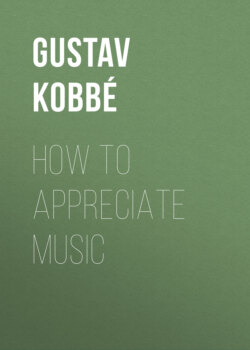Читать книгу How to Appreciate Music - Gustav Kobbé - Страница 11
На сайте Литреса книга снята с продажи.
The Clavichord.
ОглавлениеMonochord means “one string,” and the application of the term to the instrument after other strings had been added was a misnomer. The monochord on which Elena, to the evident distress of her distinguished parent, desired to play, really was a clavichord, which was derived directly from the primitive monochord.
If you will raise the lid of your pianoforte you will find that the strings become shorter from the bass up, 41 the lowest note being sounded by the longest, the highest note by the shortest string; for the longer the string the slower the vibrations and the deeper the sounds produced, and vice versa. This principle is so obvious that it seems as if it must have been applied to the clavichord almost immediately and a separate string provided for each key. But for many years the strings of the clavichord continued all of equal length, and three or four neighboring keys struck the same string, so that the contact of the upright tangent with the string not only set the latter in vibration but also served to form the node which produced the desired note. Not until after the clavichord had been in use several centuries, were its strings made of varying length and a separate string assigned to each key. These new clavichords were called bundfrei (fret-free or tangent-free) because the node of each string was determined by that string’s length and not by the contact of the tangent.
The clavichord retained the box shape of its prototype, the monochord. Originally it was portable and was set upon a table; later, however, was made, so to speak, to stand upon its own legs. In appearance it resembled our square pianofortes. It gave forth a sweet, gentle and decidedly pretty musical sound. It had a further admirable quality in its capacity for sustaining a tone, since by keeping the tangent pressed against the string the player was able to sustain the tone so long as the string continued to vibrate. Moreover, by holding down the key and at the same time making a gentle rocking motion with the finger he was able to produce a tremolo effect which German musicians 42 called Bebung (trembling), and the French balancement.
A defect of the clavichord was, however, its lack of power. This defect led to experiments which resulted in the construction of a keyboard instrument the strings of which, in response to the action of the keys, were set in vibration by jacks tipped with crow-quills or hard leather. The sound was much stronger than that of the clavichord. But the jacks twanged the strings with uniform power, “permitting a sharp outline, but no shading of the tones.”
